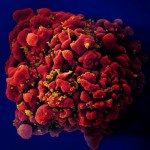Link to Pubmed [PMID] – 19812199
J. Immunol. 2009 Nov;183(9):5662-72
Foxp3(+) regulatory T cells (Tregs) are crucial for preventing autoimmunity. We have demonstrated that depletion of Foxp3(+) Tregs results in the development of a scurfy-like disease, indicating that Foxp3(-) effector T cells are sufficient to induce autoimmunity. It has been postulated that nonfunctional Tregs carrying potentially self-reactive T cell receptors may contribute to scurfy (sf) pathogenesis due to enhanced recognition of self. Those cells, however, could not be identified in sf mutants due to the lack of Foxp3 protein expression. To address this issue, we crossed the natural sf mouse mutant with bacterial artificial chromosome transgenic DEREG (depletion of regulatory T cells) mice. Since DEREG mice express GFP under the control of an additional Foxp3 promoter, those crossings allowed proving the existence of “would-be” Tregs, which are characterized by GFP expression in the absence of functional Foxp3. Sf Tregs lost their in vitro suppressive capacity. This correlated with a substantial reduction of intracellular cAMP levels, whereas surface expression of Treg markers was unaffected. Both GFP(+) and GFP(-) sf cells produced high amounts of Th2-type cytokines, reflected also by enhanced Gata-3 expression, when tested in vitro. Nevertheless, sf Tregs could be induced in vitro, although with lower efficiency than DEREG Tregs. Transfer of GFP(+) sf Tregs, in contrast to GFP(-) sf T cells, into RAG1-deficient animals did not cause the sf phenotype. Taken together, natural and induced Tregs develop in the absence of Foxp3 in sf mice, which lack both suppressive activity and autoreactive potential, but rather display a Th2-biased phenotype.

